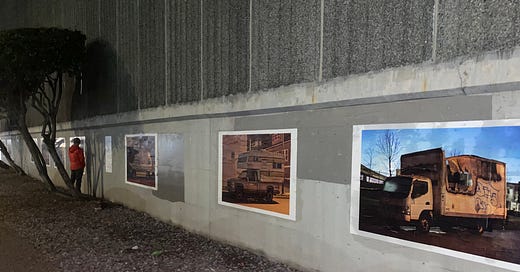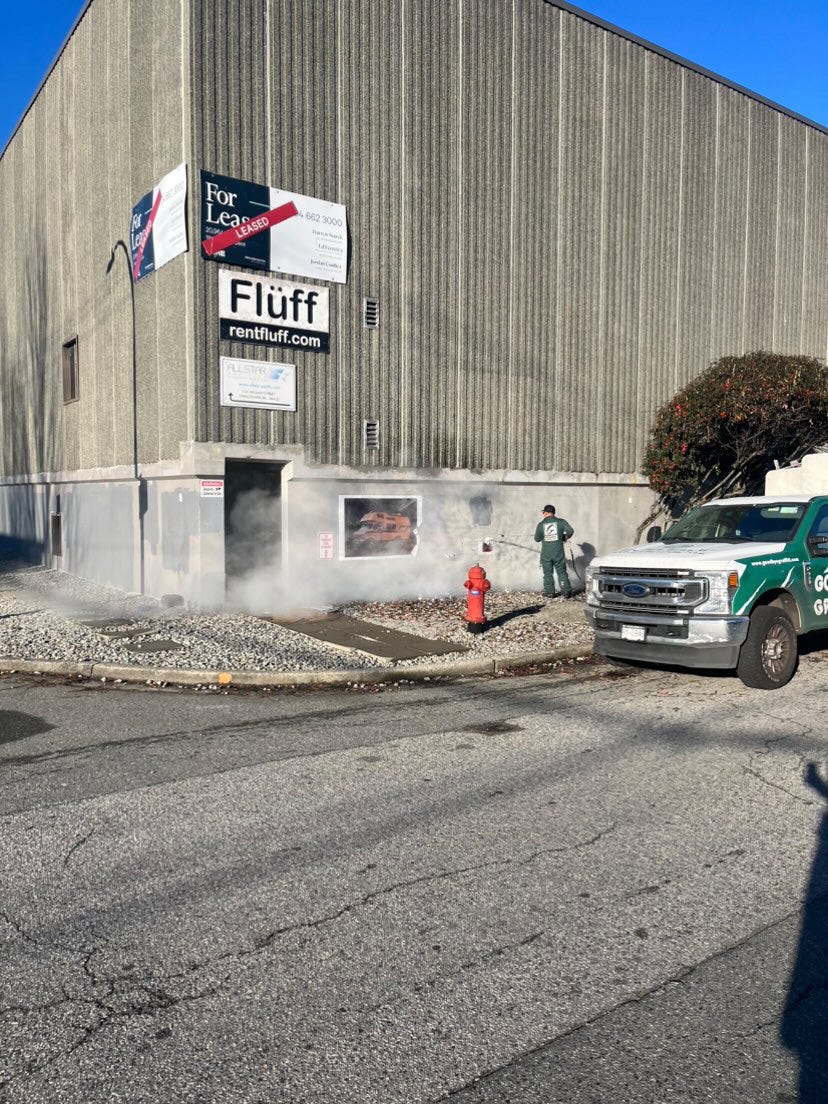There are many campers and trailers parked around Vancouver. Tucked away under bridges and overpasses. Both hidden and in plain view. In a lot of ways, these objects may be unremarkable, but they are also as much a part of our city as a condo tower or heritage home. I’ll leave what they say about our city up to you.
Astigmatic.Surveyors.Society is the artist who has been capturing photos of these objects and reframing them as wheat pastes around the city recently. The large colour photos, taken in the early morning hours offer an almost haunting image. If a person wasn’t paying attention they could almost be confused as street ads. We chatted about the work and the artist shared some big ideas about the work and the world. They also shared a photo of the work being pressure-washed off a building signifying one of the universal experiences of all street art…
Impermanence.
What’s your process for the work?
I took all of these pictures over the course of 2 or 3 years, mostly between 1 and 5 o’clock in the morning to capture the theatrical play of the urban light. No extra lighting but a few tweaks in editing most times. I didn’t often ask permission, only when someone made themselves known to me, since I only shot the publicly available view and took care to avoid including people. People were almost uniformly considerate. There’s always a danger of behaving exploitively doing photography but wheat pasting the images, unsigned and not for sale, I think adds to the content and social value of the work and mitigates against exploitation. I did enter one image into a contest last spring, which encouragingly earned a prize, but left me a little queasy. On the fence or wall it’s an open exchange of ideas. I’m re-presenting views that are publicly available (for better or worse) without making them my property, trying as best as I can to encourage an empathetic consideration of a situation that is too easily ignored or dismissed, one that implicates us all, and then more beyond that. I think one can see the care I took.
I began posting in my old neighbourhood of Hastings-Sunrise but lately I post these images on the west side. The Eastside Culture Crawl was an opportunity to address many communities at once, as tens of thousands descend upon one of the most vulnerable urban communities in Canada where many of these pictures were made. I hope I’ve presented them both respectfully and provocatively. I didn’t set out with an agenda to discuss housing instability, impoverishment or specific policy when I made the pictures, but when an artist closely examines their surroundings, things should be revealed and those issues were right at the surface. It’s not the entire content but it’s there. What I saw was theatre. A shared imagining shimmering between the public and private. Marx would have called it a false consciousness.
Tell us about the project?
I wrote about 5000 unsatisfactory words trying to answer this last night. This work didn’t arise from one thought or motivation. During the pandemic I had a little show of cellphone pictures, just bits of trash and rags I found, next to which I placed mirrored bits of trash and rags in symmetrical opposition. Ideally, you couldn’t tell which pile was original and which was the copy. I surprisingly sold quite a few of these little pictures and used the money to buy a camera body. Then I stumbled upon a technical mystery to do with aperture and that turned towards the philosophical and just kept descending into a Mandelbrot world of infinite, imperfect oppositions. I know housing insecurity was in there, but also aesthetic pleasure, and the great, self-reflexive axis of the public and private. But also this awareness of analogy, that we are made of nothing but others, and all of these characters in costume like in The Wizard of Oz, familiar but newly seen and made strange. I even nick-named the trailer with the orange tarp “Judy” since she might easily wander out from behind it singing wistfully at any moment. My filing system is basically just handing out nick-names.
I’m never clear on whether to include the text or not. One of the first formulations generated while I did this work was "To live out one’s private life in public is either a profound degradation or, paradoxically, among the highest affirmations of contemporary status.” Another early one was “Private and public are the opposing jaws with which we consume the world.” I grew up with a sense that public ownership was better than private, that a sense of shared trust was beneficial and private exploitation less desirable. Now I see them working in concert like a peristaltic tract, a piston stroke or the aforementioned jaws. In any case, I think these oppositions shimmer, the sequins on a singer’s gown.
At some point this cleaving of experience along the lines of public and private became my focus, and the camper or motorhome became my subject, specifically, the thin membrane of sheet metal, insulation and panelling separating the bubble of a private life from the public space surrounding it.
By then I was studying up on the history of the public and private and surprised to learn that they essentially reversed their meanings during the early modern period, 1450-1750. Perhaps instead we could imagine they flipped their axis from the medieval horizontal of a few public figures presiding over a mass of people suffering privations to a vertical axis, fractally multiplied in shifting and laminar relationships like a house of mirrors extending toward every horizon. All the freedoms post-feudal Europeans learned to exploit were expressed in this shift, fuelled by the discovery of “new” worlds. Colonialization conflates expansion of a public realm with private ambition. Democracy promised a fractal sovereignty, everyone a king, all bound up with the idea of rapid public and private sectioning of territory. Concepts such as the public sphere and the public-at-large began to emerge and refine themselves along the lines of shared interests. Professional theatre itself comes into existence at this time, as if it were a cipher for this re-imagining of the world and of the self. Our conception of human rights dates from this moment, first expressed as a limit on property rights of slave owners. Consumer culture is spawned. When I look at a camper on the street, I see a folded history extending back 800 years or more.
What project would you do with unlimited resources?
I assume I always have exactly the resources to do the work at hand. Any more would be a waste.






